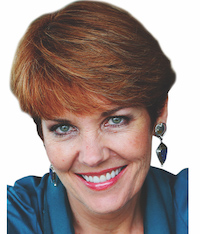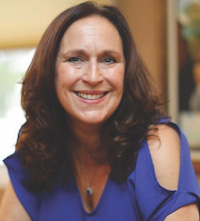While 2020 threw monkey-wrench-type challenges into businesses across the spectrum, the home furnishings industry — both for interior designers and retailers after lockdowns were lifted — have for the most part thrived through this pandemic and economic uncertainty. Consumers are home, and home has had to be more this past year than it has in years past — the office, school, a vacation spot. Once vaccines are here, some activities may bounce back to more of what was once considered normal, but much of what we’ve had to pivot to quickly is likely here to stay.
To make sure we’re all ready for 2021, whatever that may bring, we talked with coaches and experts across the retail and design industries to learn just what you should be assessing in your businesses to ensure continued success in the coming year.
Some of it you probably know; some of it may be new. Whether lessons or reminders, these experts share some stellar advice that could help elevate your entrepreneurial business in
the coming year.
Deliver What Clients Are Looking For

- Follow real estate trends because, right now and going forward, seismic shifts in where and how the professional workforce lives and works are underway. Remote working has proven successful, and it is causing an exodus from major metropolitan areas to second home residences and a more relaxed way of life.
- Less travel in 2021 means clients will invest more at home. Educate them of the long-term value and how you can bring the world to their interiors with global resources.
- The home as a sanctuary and source of wellness is more important than ever before. Exploring sustainable materials and furnishings as well as what wellness means to your clients is paramount. Home is the zone for healthy, happy and safe from
- the uncertainty.
- Focus on creating productive spaces (often more than one) for remote workers at every level of the market.
- Create educational spaces for kids who are doing more Zoom schooling than they are doing in real classrooms. Parents need
- them settled and learning instead of continually interrupting.
- Outdoor spaces are taking on a new priority. Nature heals many ills, so time outdoors is more critical than ever. The exterior is becoming an extension of the interior. Don’t let a landscape company or your client do this on their own; you’re the expert in creating these spaces, so dive in.
- Digital is king both for communication and for the delivery of design with your clients right now; get comfortable and good at it.
- Delegating tasks in your interior design business has never been more important; build your team of resources online, and stay nimble and flexible to meet changing market needs. Burying yourself with employees is precarious in uncertain times.
Melissa Galt: Interior Design Business Coach, Author and Interior Designer, Melissa Galt focuses on helping you put the steps in place to run a more profitable interior design business. Her latest book is Marketing Luxury Design: Attracting Affluent Clients. To learn more about Melissa Galt, visit www.melissagalt.com
Build Relationships, Processes

- Relationships are more important than ever. Know who your fabulous 50 are — the people whose circles you want to be in — and build those relationships.
- How do you find them? Look at where your past ideal clients spend their time, especially right before they hired you. Find the patterns that lead them to a design project. What podcasts are they listening to? What books are they reading?
- Engage with your “fabulous 50” on social media in a meaningful way. Pick up the phone and get to know them. Share your service models and let them know if they need you, you’re there for them. Create the bridge.
- In this day and age, you need to have different service models for different needs. Think of offering “designer for a day” or “designer on call.” Have different price points that lend different levels of service in your business. People are cautious with their money right now but they still have a need. With more service models, you can close more sales.
- Now’s the time to take the time to make decisions for your business, before you’re in front of your clients. Get ready for 2021 by getting your process in place. What is it your company will to do or not do? Don’t go in expecting to make decisions on the spot. Take action now so you’re prepared when in front of clients.
Nancy Ganzekaufer: Nancy Ganzekaufer is a Speaker, Certified Body Language Trainer, Author and Business Coach to interior designers and an expert in topics such as marketing, sales, profitability and systems for your interior design business. To learn more about Nancy Ganzekaufer, visit www.nancyganzekaufer.com
Put Yourself Out There

- Take stock. With so many changes to the design landscape, this is a perfect time to assess the who, what, how, and more importantly, why clients are looking to make changes in the home.
- Hand-off for happiness. Know your strengths (and weaknesses). Unfortunately, few of us have a well of extra time and energy on hand. Don’t be afraid to hire the help you need to get your story/brand/image out there.
- It’s the players, not the game. In the media world, editors and publishers are moving from masthead to masthead faster than you can get a new project submitted. Be sure to do your research and find out who is going where!
- Selfie-substance. It’s time to use your experience to help others.
- Whether it’s a video diary of your design challenges or a weekly newsletter for your clients, be sure to share your knowledge where you can. Self-generated content is more important than ever.
Bob Gaynor: Bob Gaynor is a Creative Director, Business Development and Brand Management Specialist focused on the interior design and home goods arena. Gaynor offers qualified brands creative direction, licensing, brand management and communications strategies for the modern home consumer. For more information on Bob Gaynor, go to: www.dcinteriormanagement.com
Know Your Worth, Long-Term Focus

- Know your worth, your real value to your client. Our research regularly proves that designers undervalue what clients are willing to pay for their services and expertise. Every one of the clients we worked with in the last two years has raised their rate by 25 to 50 percent. They didn’t lose an account and are now more profitable. Be confident in who you are and get paid for it.
- Take the longer-view approach to design. Build in future business by establishing a multiyear timeline of design that will need to occur as home life evolves. Essentially, as you design a current project, incorporate for your client the thought that in two, four or six years, they will want to consider future design efforts; build these thoughts into a multi-year design business plan.
- Architects and designers have a greater ability to improve health than medical professionals.” – Dr. Claudia Miller, University of Texas. By providing good design, you improve the health of your clients. The medical industry knows this and you should too. Get educated on the developing health benefits of good design. Study the science and medical industries that are studying what you do. Embrace the medical science behind design and include it in your sales and marketing efforts. You improve health; take credit for it.
Mike Peterson: Founder of marketing and brand firm Visionary Design Marketing, Peterson has passion, experience and is committed to brand marketing concepts that help companies, large and small, better understand how to grow their businesses. For more on Mike Peterson, visit www.visionarydesignmarketing.com
Lean Into Technology

- We should lean into the virtual. In a recent podcast interview with Chris Wallace, Co-founder and President of marketing consulting firm Innerview, we talked about how 21st-century selling has to include all kinds of technology, including virtual. He has convinced me.
- One thing I feel is important for 2021 is to look at yourself and your business and decide what technology you’re going to adopt. Is it virtual selling, doing Instagram or creating a video series? You need to be tech savvy in your business, and go more in depth, depending on your reason. It’s incredibly valuable to pick that as the thing you have to do.
- How you embrace technology depends on your comfort level. Meet it where you can and then push yourself out of your box just a little bit. For someone who is already tech-savvy, now is the time to push for a full-on digital platform and promotion. But push yourself beyond what’s comfortable and learn something new.
- In this era where designers are enamored with being able to say they have projects beyond just their own location, you can be that designer virtually if you have the platform in place. As you create your presence online and share through social media, if you bring technology to your process, you can really expand your reach.
- All good business practices have to come with us year to year. In 2021, the new twist would be to take those good business practices and apply them to a true focus on technology, moving beyond your current level of understanding.
LuAnn Nigara: Speaker, Author and Podcast Host of A Well-Designed Business, LuAnn Nigara focuses on being a resource for interior design professionals interested in operating a profitable and productive business. Learn more about LuAnn Nigara at www.luannnigara.com
Focus On What You Can Control

- As we can continue in this era of uncertainty heading into 2021, the best thing to do in your business is to focus on what you know, what you have and what you can control. Put the uncertain elements of your business on the back burner for now. If you put effort into predicting what’s to come, there’s a good chance you’ll expend a lot of energy and get that wrong. So focus on what you know is within your control. This situation could last a long time. We thought this pandemic would last about three months in the beginning; we thought 20 percent to 30 percent of home remodeling businesses might not make it through. We were wrong on both fronts. Prepare for the unknown, sure, but don’t try to predict the future.
- One thing we do know is that the coronavirus pandemic is changing how we do business. We know it is essential to leverage technology. We don’t know when the big showrooms and shows will be back, and we’ve gotten better and better at sourcing and selling without having to get in the car to do that.
- The whole sales process today can be related virtually with tools like Zoom. The client is integrated into the process, it takes half the time, and the client feels happy and safe. It’s being done very successfully. It allows more family members, too, to be involved in the process because they are around now.
- Don’t keep it a secret if you are putting time and energy into being safe. Clients have been very clear that they want to be safe and they don’t want to touch you. Contactless interaction with your clients from materials selection to completing the transaction all the way through installation and deliveries is here to stay. Focus on the experience your clients are looking for as much as the service and product you are providing.
Mark Richardson: Podcast Host, Speaker and Author, Richardson focuses on the home remodeling industry. His podcast — Remodeling Mastery — is designed to elevate home design businesses. Learn more about Mark Richardson through his Remodeling Mastery podcast.
Engage The Public In New Ways

- Retailers need to realize new ways to engage an untrusting public after this coronavirus pandemic. The masks may be gone at some point next year, but consumers in general have gotten a little bit out of the in-person shopping mode. You have to sell online. We need to find new ways to build rapport and get the whole sale. Technology can be part of that.
- Clearly, retail is moving to one shopping basket. If I can go online to your website and I can connect via video to get help or complete my purchase in the store, ultimately, that’s what everyone is trying to get to. You need to understand the technologies that will allow you to do that. Locally, you want to be part of a retail “Uber Eats.” People can buy online and have their purchases delivered in a couple of hours.
- Today’s online retailers are in a stronger position. Consumers want contactless payments, especially in Millennial and Gen Z demographics. Take steps toward that as many consumers want to shop, but still want limited contact in stores.
- Connect with your customers in the right way, whether online or in person. Instead of, “How can I help you,” you should be asking, “What room gets the makeover?” Many consumers working from home now have more time without commutes. They’re spending more time at home and they have money to invest. They are looking for that elevated shopping experience when and where they want it.
Bob Phibbs, CEO, The Retail Doctor, is a NY-based retail consultant with more than 30 years experience helping brick-and-mortar retailers implement exceptional retail shopping experiences and helping his clients increase sales. To learn more about Bob Phibbs, visit www.retaildoc.com.
Embrace Redefined Shopping

- Accept that you have to change at retail. There has been a huge disruption and it’s not going to ease back to what it was before. Commerce, competition and customers have changed. Community has changed as well. Understand how that impacts your business and do what you can in response.
- Shopping is redefined. A reexamination of priorities from a retail and consumer perspective have to be taken, and we have to talk about the consumer’s path to purchase. What happens between, “I want to buy,” and the actual transaction? COVID has changed how the consumer shops.
- Independent retailers are fortunate in that you can offer customized care and more tailored shopping opportunities. Leverage that to make your customers feel secure. Understand what that security looks like to your audience and figure out how to strengthen it. Today, consumers want transactions on their terms. They want to feel connected, yet safe. The in-store experience continues to be important, and your online presence needs to mimic in-store more than ever. Leverage technology and good old-fashioned communication to get that done.
- Strong communication can’t be dismissed. Be clear in what you are offering your audience. We can’t always assume that our audience understands what we’re saying. There needs to be heightened communication, especially now. How do you ensure that they understand how your store is sanitized? Do they understand the culture of your business?
- Consumers have this “glocal” — local and global — economy at their fingertips. Business leaders need to figure out how to capture more customers. Support local communities, explain your value on social media or put a stamp on the back of every receipt that shares something about your business your clients should know. Engage the local media about the importance of supporting small businesses. You need to compete in that “glocal” economy.
- You need to have a website; whether or not it’s e-commerce is another question. Lacking some type of website prohibits you from being part of online review platforms and searches.
- Understand your target customers. Baby boomers spend more time buying online than any other generation. Young home buyers are more digitally savvy. Engage them via social media or Zoom, and integrate video into your marketing strategy. Jump on the bandwagon.
Nicole Leinbach Reyhle is the Founder and Publisher of RetailMinded.com, a retail industry resource that has been recognized worldwide for its leading business insights since 2007. Retail Minded’s core concentration focuses on independent retailers, small businesses, technology and how the various touchpoints of commerce influence modern merchants. Learn more about Nicole Leinbach Reyhle at www.retailminded.com



